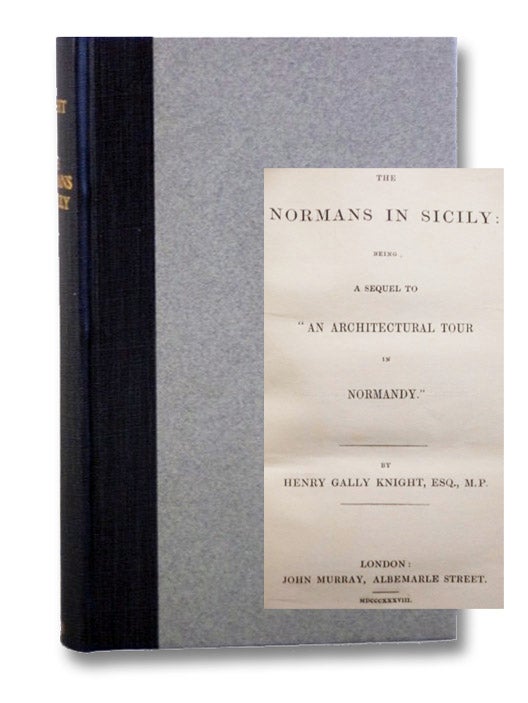
The Normans in Sicily: Being a Sequel to 'An Architectural Tour in Normandy.'
London: John Murray, Albemarle-Street / G. Woodfall, Angel Court, Skinner Street, 1838. First Edition. Hard Cover. Near Fine / No Jacket. Item #2198669
First edition (Pine-Coffin 836.2). Rebound, blue cloth spine, gilt titles, paper over boards, new endpapers and flyleaves. Minimal pencil marginalia, owner bookplate of J. Leon Williams on front endpaper, small slip of paper with two names in ink (Susan Morgan & Sara Traven) laid in.
vii, 355, 12 pp. 8vo. A historical account of the Normans, paired with a travelogue based on an architectural tour of Sicily to study the influence of the Normans, by a British M.P., traveler, and writer who served as High Sheriff of Nottinghamshire in 1814-15. "Knight, Henry Gally (1786–1846), architectural writer and antiquary, was born on 2 December 1786, the only son of Henry Gally Knight (d. 1808) of Langold Hall, Yorkshire, barrister, and his wife, Selina, daughter of William Fitzherbert of Tissington, Derbyshire. His grandfather John Gally (who assumed the additional name of Knight) was MP for Aldborough and Boroughbridge, and a son of Henry Gally DD, the classical scholar. The diplomatist Alleyne Fitzherbert, Baron St Helens, was his uncle; the novelist Frances Jacson was his aunt.Knight was educated at Eton College, and entered Trinity Hall, Cambridge, in 1805; he was in residence there until succeeding to the family estates on his father's death in 1808, when he left Cambridge without taking a degree. In 1809 he travelled to Spain, where he purchased works by Spanish painters. During 1810–11 he travelled in Greece, Egypt, and Palestine with Frederick Sylvester North Douglas and John Nicholas Fazakerley. He was a founder member of Grillion's Club in 1812. Between 1816 and 1830 he published a number of poems, including ‘Ilderim, a Syrian Tale' (1816), which often drew inspiration from his earlier travels. His poetry received mixed reviews from Byron. In 1814, through a family connection with the fourth duke of Newcastle, Knight was returned as MP for Aldborough, but resigned the seat in the following year when he supported Catholic emancipation, against the wishes of his patron. He joined Brooks's Club in 1816 and associated with the group of whigs who followed the second Earl Fitzwilliam, opposing the repressive measures taken by the government against popular protest. Out of parliament, he remained active in public affairs in Nottinghamshire. He married, on 13 July 1825, Henrietta (d. 1848), widow of her first cousin John Hardolf Eyre and daughter of Anthony Hardolph Eyre of Grove Park, Nottinghamshire. They had no children. In 1828 he wrote a pamphlet on the Foreign and Domestic View of the Catholic Question. He returned to parliament in 1831 as MP for Malton, a seat owned by Fitzwilliam, and supported parliamentary reform, but did not stand at the general election in 1832. In 1835, by then a Conservative, he was elected for North Nottinghamshire, which he represented until his death. As an MP he was regarded by his contemporaries as a fluent but infrequent speaker. In May 1831 Knight, accompanied by the architect Richard Hussey, had travelled to France to study the buildings and libraries of Normandy. After his return to England he published An Architectural Tour in Normandy (1836), which was translated into French by M. A. Campion and published in Caen in 1838. This work had a significant influence upon the French antiquarian Arcisse de Caumont, and in recognition of his work Knight was made a foreign member of the Société Française. In August 1836 he travelled to Messina with the architect George Moore, a pupil of Edward Blore. Knight produced two books relating to this expedition: The Normans in Sicily (1838; French translation by M. A. Campion, 1839; German translation, ed. C. R. Lepsius, 1841) and Saracenic and Norman Remains to Illustrate the ‘Normans in Sicily' (1840). In 1842–4 he published the two-volume The Ecclesiastical Architecture of Italy from … Constantine to the 15th Century, with eighty-one litho-chromatic plates, some by Owen Jones. Although Knight's work was that of an amateur antiquarian and lacked acute stylistic analysis, his books did influence some early Victorian architects. The Ecclesiastical Architecture of Italy in particular provided accurate, visual documentation relating to Italian medieval architecture. Of great interest were the details of the various characteristic orms of polychromy. In 1841 Knight was a member of the select committee on the fine arts, which initiated the historical fresco paintings in the houses of parliament. He was also deputy lieutenant of Nottinghamshire. He died in Lower Grosvenor Street, London, where he lived, on 9 February 1846, and was buried in Firbeck church, Yorkshire, on 17 February. His will directed that his Langold estate should be sold for the benefit of some friends. His other estates at Firbeck, Kirton, and Warsop were left to his widow during her lifetime. After her death the Firbeck estate and mansion were to go to the ecclesiastical commissioners for charitable uses. Some manuscripts relating to Knight's tour in 1810–11 remained in the hands of his family." - Oxford Dictionary of National Biography
Price: $90.00
